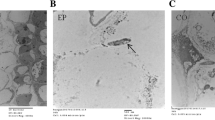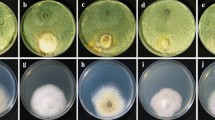Abstract
Sclerotium rolfsii, a soil-borne fungal pathogen, infects more than 500 crop species and causes stem rot/collar rot/seed rot/southern blight/wilt in a wide variety of crops which results in significant yield loses. Presently, antagonistic microbes are gaining more importance in managing plant pathogens because they control the pathogen in an environment-friendly manner. Trichoderma is an antagonistic fungi and most popularly used biocontrol agent against phytopathogenic fungi. It is predominantly used to treat soil and seed for the control of Sclerotium rolfsii infestation. In this study, the Trichoderma koningii IABT1252 that performed better in controlling groundnut seed/ seedling rot caused by S. rolfsii in pot experiments were selected to know the molecular basis for the control. Differentially expressed genes in Trichoderma at two different stages of interaction (prior to contact and after contact with S. rolfsii) were identified. In both the stages, some of the differentially expressed genes included ones coding for hydrolytic enzymes, secondary metabolite biosynthesis, transcription factors, signaling proteins, transporter proteins, and proteins involved in mycoparasitic process of Trichoderma.


Similar content being viewed by others
References
Jenkins SF, Averre CW (1986) Problems and progress in integrated control of southern blight of vegetables. Plant Dis 70:614–619
Aycock R (1966) Stem rot and other diseases caused by Sclerotium rolfsi. North Carolina Agricultural Experimental Station. Tech. Bull pp. 174–202.
Brown EA, Hendrix FF (1980) Distribution and control of Sclerotium rolfsii on apple. Plant Dis 64:205–206
Mayee CD, Datar VV (1988) Diseases of groundnut in the tropics. Rev Trop Plant Pathol 5:85–118
Inbar J, Menendez A, Chet I (1996) Hyphal interaction between Trichoderma harzianum and Sclerotinia sclerotiorum and its role in biological control. Soil Biol Biochem 28:757–763
Varadharajan K, Ambalavanan S, Sevugaperumal N (2006) Biological control of groundnut stem rot caused by Sclerotium rolfsii (Sacc). Arch Phytopathol Plant Prot 39:239–246
Carpenter MA, Alison S, Hayley JR (2005) Identification of novel Trichoderma hamatum genes expressed during mycoparasitism using subtractive hybridization. FEMS Microbiol Lett 251:105–112
Inbar J, Chet I (1995) The role of recognition in the induction of specific chitinases during mycoparasitism by Trichoderma harzianurm. Microbiol 141:2823–2829
Pabline VM, Alexandre SGC, Andrei SS, Saulo JLS, Roberto NS, Cirano JU (2013) Identification of differentially expressed genes from Trichoderma harzianum during growth on cell wall of Fusarium solani as a tool for biotechnological application. BMC Genomics 14:177–188
Suarez MB, Sanz L, Chamorro MI, Rey M, González FJ, Llobell A, Monte E (2005) Proteomic analysis of secreted proteins from Trichoderma harzianum identifcation of a fungal cell wall-induced aspartic protease. Fungal Genet Biol 42:924–934
Mala M, Prasun KM, Sharad PK (2007) cAMP signalling is involved in growth, germination, mycoparasitism and secondary metabolism in Trichoderma virens. Microbiology 153:1734–1742
Chidanand AR, Sumangala B, Krishnaraj PU (2015) Characterization of selected Trichoderma isolates with antifungal activity. J Pure Appl Microbiol 9:357–365
Diatchenko L, Yun-fai CL, Aaron P, Campbell AC et al (1996) Suppression subtractive hybridization: a method for generating differentially regulated or tissue-specific cDNA probes and libraries. Proc Natl Acad Sci USA 93:6025–6030
Ruocco M, Lanzuise S, Vinale F, Marra R, Turra D, Woo SL, Lorito M (1996) Identification of a new biocontrol gene in Trichoderma atroviride: the role of an ABC transporter membrane pump in the interaction with different plant-pathogenic fungi. Mol Plant Microbe Interact 22:291–301
Haran S, Schickler H, Chet I (1996) Molecular mechanisms of lytic enzymes involved in the biocontrol activity of Trichoderma harzianum. Microbiology 142(9):2321–2331
Chomczynski P, Sacchi N (1987) Single-step method of RNA isolation by acid guanidinium thiocyanate-phenol-chloroform extraction. Anal Biochem 162(1):156–159
Mukherjee PK, Buensanteai N, Moran-Diez ME, Druzhinina IS, Kenerley CM (2011) Functional analysis of non-ribosomal peptide synthetases (NRPSs) in Trichoderma virens reveals a polyketide synthase (PKS)/NRPS hybrid enzyme involved in the induced systemic resistance response in maize. Microbiology 158(1):155–165
Lairson LL, Henrissat B, Davies GJ, Withers SG (2008) Glycosyltransferases: structures, functions, and mechanisms. Ann Rev Biochem 77(1):521–555
Elizabeth MC, Edgardo UE, Martin H, Alfredo HE (2014) Extracellular ATP activates MAPK and ROS signaling during injury response in the fungus Trichoderma atroviride. Front Plant Sci 5:659
Lea A, Stephane LC, Sabine G, Fanny C, Verena SS, Christian PK, Irina SD (2013) Comparative transcriptomics reveals different strategies of Trichoderma mycoparasitism. BMC Genomics 14(1):121
María de las MD, José AP, Beatriz C (2006) Transgenic tobacco plants overexpressing chitinases of fungal origin show enhanced resistance to biotic and abiotic stress agents. Plant Physiol 142(2):722–730
Rodney JD, Mark P, Andrew JWR (2008) The structure and function of mitochondrial F1F0-ATP synthases. Int Rev Cell Mol Biol 267:1–58
Rubio MB, Hermosa R, Reino JL, Collado IG, Monte E (2009) Thctf1 transcription factor of Trichoderma harzianum is involved in 6-pentyl-2H-pyran-2-one production and antifungal activity. Fungal Genet Biol 46:17–27
Lalitha V, Kiran B, Raveesha KA (2012) Antifungal activity of Trichoderma koningii Oudm against seed borne fungal species of paddy. Int J Innov BioSci 2:176–180
Masahiro N, Hiroya T, Aya K, Kenji O, Hirofumi O, Yasushi M (1998) Purification and characterization of Exo-β-D-glucosaminidase from a cellulolytic fungus, Trichoderma reesei PC-3-7. Appl Environ Microbiol 64(3):890–895
Divne C, Stahlberg J, Reinikainen T, Ruohonen L, Pettersson G, Knowles JK, Teeri TT, Jones TA (1994) The three-dimensional crystal structure of the catalytic core of cellobiohydrolase I from Trichoderma reesei. Science 265(5171):524–528
Vasara T (2002) Functional analysis of the RHOIII and 14-3-3 proteins of Trichiderma reesei. VTT Publication, Finland, p 466
Hahn M, Neef U, Struck C, Göttfert M, Mendgen K (1997) A putative amino acid transporter is specifically expressed in haustoria of the rust fungus Uromyces fabae. Mol Plant Microbe Interact 10(4):438–445
Andrei SS, Marcelo HSR, Alexandre SGC, Robert NGM, Georgios JPJ, Cirano JU, Eliane FN (2014) Identification of mycoparasitism related genes against the phytopathogen Sclerotinia sclerotiorum through transcriptome and expression profile analysis in Trichoderma harzianum. BMC Genomics 15(1):204
Barbara R, Enrique IL, Robert LM, Alfredo HE (2011) Identification of mycoparasitism-related genes in Trichoderma atroviride. Appl Environ Microbiol 77(13):4361–4370
Portnoy T, Antoine M, Rita L, Lea A et al (2011) The CRE1 carbon catabolite repressor of the fungus Trichoderma reesei: a master regulator of carbon assimilation. BMC Genomics 12(1):269
Gupta YK (2014) Investigating the role of the exocyst complex in infection-related development of the rice blast fungus Magnaporthe oryzae, PhD Thesis, Univ Exeter, London
Scherm B, Monika S, Virgilio B, Christian PK, Quirico M (2009) Identification of potential marker genes for Trichoderma harzianum strains with high antagonistic potential against Rhizoctonia solani by a rapid subtraction hybridization approach. Curr Genet 55(1):81–91
Kershaw MJ, Talbot NJ (1998) Hydrophobins and repellents: proteins with fundamental roles in fungal morphogenesis. Fungal Genet Biol 23(1):18–33
Chet I, Benhamou N, Haran S (1998) Mycoparasitism and lytic enzymes, in Trichoderma and Gliocladium: enzymes, biological control and commercial applications. In: Harman GE and Kubicek CP (eds), vol 2. Taylor and Francis, London, pp 153–171
Haran S, Schickler H, Oppenheim A, Chet I (1995) New components of the chitinolytic system of Trichoderma harzianum. Mycol Res 99(4):441–446
Hunsley H, Burnett JH (1970) The ultrastructural architecture of the walls of some hyphal fungi. J Gen Microbiol 62(2):203–218
Sivan A, Chet I (1986) Biological control of Fusarium spp. in cotton, wheat and muskmelon by Trichoderma harzianum. J Phytopathol 116(1):39–47
Geremia RA, Goldman GH, Jacobs D, Ardiles W, Vila SB, Montagu VM, Alfredo HE (1993) Molecular characterization of the proteinase-encoding gene, prb1, related to mycoparasitism by Trichoderma harziunum. Mol Microbiol 8(3):603–613
Schmidt A, Alan H (2002) Guanine nucleotide exchange factors for Rho GTPases: turning on the switch. Genes Dev 16:1587–1609
Omero C, Inbar J, Rocha-Ramirez V, Alfredo HE, Chet I, Horwitz BA (1999) G protein activators and cAMP promote mycoparasitic behaviour in Trichoderma harzianum. Mycol Res 103(12):1637–1642
Lee N, D’Souza CA, Kronstad JW (2003) Of smuts, blasts, mildews, and blights: cAMP signaling in phytopathogenic fungi. Ann Rev Phytopathol 41(1):399–427
Lilian DSC, Wellington RP, Amanda CCA, Andrei SS et al (2014) Comparative metabolism of cellulose, sophorose and glucose in Trichoderma reesei using high-throughput genomic and proteomic analyses. Biotechnol Biofuels 7(1):41–58
Chidanand AR, Sumangala B (2015) Expression profiling of mycoparasitic genes in Trichoderma koningii IABT1252 during its interaction with Sclerotium rolfsii. J Mycol Plant Pathol 45:257–262
Author information
Authors and Affiliations
Corresponding author
Additional information
Publisher's Note
Springer Nature remains neutral with regard to jurisdictional claims in published maps and institutional affiliations.
Electronic supplementary material
Below is the link to the electronic supplementary material.
Rights and permissions
About this article
Cite this article
Rabinal, C., Bhat, S. Identification of Differentially Expressed Genes in Trichoderma koningii IABT1252 During Its Interaction with Sclerotium rolfsii. Curr Microbiol 77, 396–404 (2020). https://doi.org/10.1007/s00284-019-01838-x
Received:
Accepted:
Published:
Issue Date:
DOI: https://doi.org/10.1007/s00284-019-01838-x




